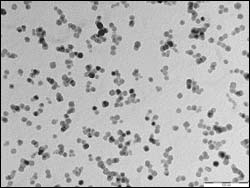Scientists to tackle illness with ‘silver bullet’

Transmission Electron Microscope (TEM) image of silver nanoparticles produced by the Leicester source with an average diameter of about 15nm (1,000 times smaller than the width of a human hair). The average size of the particles emerging from the machine can be controlled in the range 5nm - 20nm.
This property of silver has caused great interest especially as new resistant strains of bacteria have become a serious problem in public health.
For example MRSA bacteria kill 5,000 hospital patients a year in the UK alone and any method of attacking them, not involving normal antibiotics, is becoming increasingly important.
Silver in the form of nanoparticles is even more effective, partly because of the high surface/volume fraction so that a large proportion of silver atoms are in direct contact with their environment. In addition, nanoparticles are sufficiently small to pass through outer cell membranes and enter cells’ inner mechanisms.
A recent medical study showed that only silver nanoparticles with sizes less than 10 nm (1,000 times smaller than the width of a human hair) were able to enter cells and disrupt them. The same study showed that silver nanoparticles are highly toxic to the bacteria that colonise the lungs of cystic fibrosis sufferers often with fatal consequences.
Another study indicated that there may be a role for nanoparticles in the fight against AIDS by showing that silver nanoparticles of the same size attach themselves to structures on the surface of the HIV virus and prevent it from binding to host cells.
Professor of Nanoscience at the University of Leicester, Chris Binns, commented: “Clearly there are important medical treatments using silver nanoparticles and this is just one of the examples of how nanotechnology shows great promise in healthcare.
“One of the problems, however, is in getting assemblies of nanoparticles of the same size into the right environment, for example on the surface of a wound dressing or in a colloidal suspension that can either be turned into an aerosol or injected into the body.
“The medical studies carried out so far acknowledge that in existing commercially available nanoparticle suspensions, only 1% of the material consists of nanoparticles of the right size. The Condensed Matter Physics group in Leicester has many years’ experience in designing and building sources of size-selected metal nanoparticles.
“With support from the “Higher Education Reach –Out to Business and the Community Innovation and Regional Fund” (HIRF) this is now being put to good use to develop a machine specifically to produce nanoparticle assemblies for medical applications. The impressive uniformity of silver nanoparticles produced by the source is illustrated in the figure (available on request) and the design enables the nanoparticles to either be coated onto a solid surface or incorporated into a liquid suspension.”
Trials of the anti-microbial effectiveness of the nanoparticle suspensions will begin shortly.
Media Contact
More Information:
http://www.le.ac.ukAll latest news from the category: Life Sciences and Chemistry
Articles and reports from the Life Sciences and chemistry area deal with applied and basic research into modern biology, chemistry and human medicine.
Valuable information can be found on a range of life sciences fields including bacteriology, biochemistry, bionics, bioinformatics, biophysics, biotechnology, genetics, geobotany, human biology, marine biology, microbiology, molecular biology, cellular biology, zoology, bioinorganic chemistry, microchemistry and environmental chemistry.
Newest articles

Properties of new materials for microchips
… can now be measured well. Reseachers of Delft University of Technology demonstrated measuring performance properties of ultrathin silicon membranes. Making ever smaller and more powerful chips requires new ultrathin…

Floating solar’s potential
… to support sustainable development by addressing climate, water, and energy goals holistically. A new study published this week in Nature Energy raises the potential for floating solar photovoltaics (FPV)…

Skyrmions move at record speeds
… a step towards the computing of the future. An international research team led by scientists from the CNRS1 has discovered that the magnetic nanobubbles2 known as skyrmions can be…





















